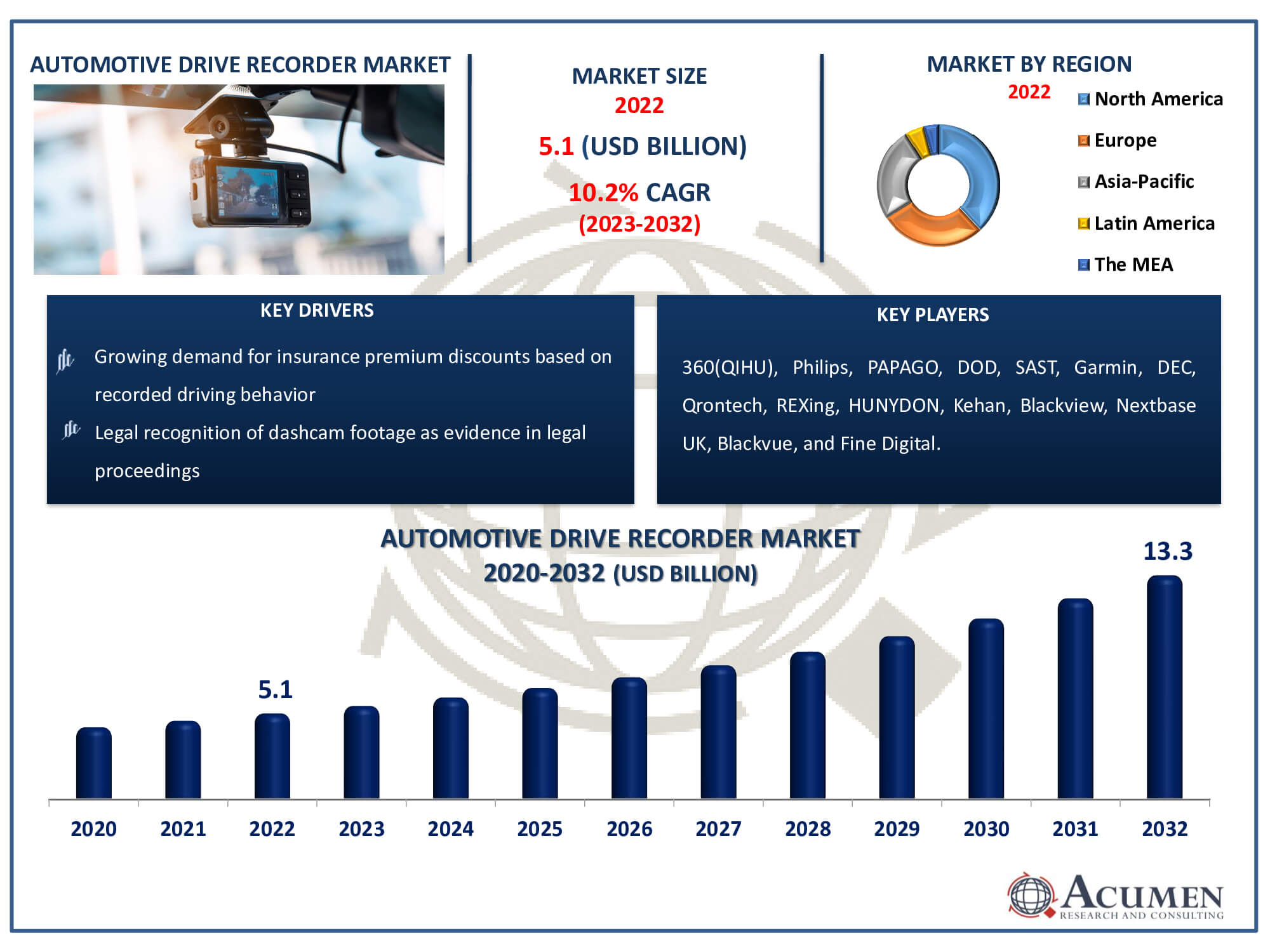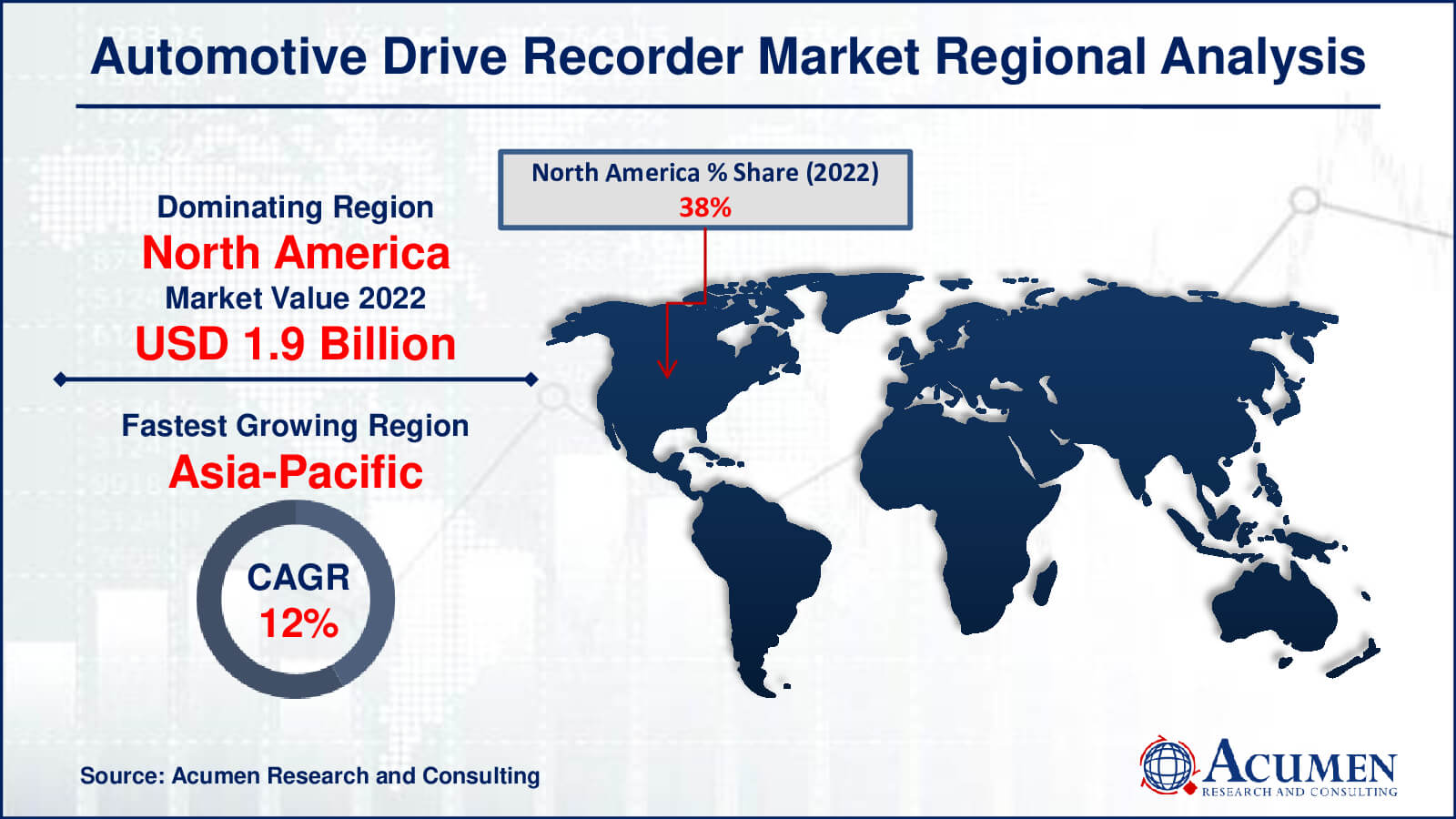August 2020
Automotive Drive Recorder Market Size accounted for USD 5.1 Billion in 2022 and is estimated to achieve a market size of USD 13.3 Billion by 2032 growing at a CAGR of 10.2% from 2023 to 2032.
The Automotive Drive Recorder Market Size accounted for USD 5.1 Billion in 2022 and is estimated to achieve a market size of USD 13.3 Billion by 2032 growing at a CAGR of 10.2% from 2023 to 2032.
Automotive Drive Recorder Market Highlights

Automotive drive recorders, also known as car cameras, automotive recorders, driving recorders, digital video recorders, etc., are compact and intelligent camcorders used by drivers to safeguard themselves in the event of an accident. Initially, when dashcams were introduced, they were directly wired into the vehicle's 12V electrical system. Typically, power is drawn from a source that is active when the ignition is in the accessory or run position. This is because automotive drive recorders are designed to continuously record whenever they are powered on. They are usually programmed to activate whenever they receive power. These recorders are engineered to consistently store video data on removable storage media, such as an SD card, hard drive, or other devices. Primarily, these cameras are utilized to aid drivers in parking, evaluate vehicle performance, provide night vision, and collect crucial evidence. Moreover, they incorporate advanced computer vision algorithms, extracting meaningful data from captured images to assist drivers in various situations, playing a pivotal role in advanced driver assistance systems (ADAS).
Global Automotive Drive Recorder Market Dynamics
Market Drivers
Market Restraints
Market Opportunities
Automotive Drive Recorder Market Report Coverage
| Market | Automotive Drive Recorder Market |
| Automotive Drive Recorder Market Size 2022 | USD 5.1 Billion |
| Automotive Drive Recorder Market Forecast 2032 | USD 13.3 Billion |
| Automotive Drive Recorder Market CAGR During 2023 - 2032 | 10.2% |
| Automotive Drive Recorder Market Analysis Period | 2020 - 2032 |
| Automotive Drive Recorder Market Base Year |
2022 |
| Automotive Drive Recorder Market Forecast Data | 2023 - 2032 |
| Segments Covered | By Type, By Application, And By Geography |
| Regional Scope | North America, Europe, Asia Pacific, Latin America, and Middle East & Africa |
| Key Companies Profiled | 360 (QIHU), Philips, PAPAGO, DOD, SAST, Garmin, DEC, Qrontech, REXing, HUNYDON, Kehan, Blackview, Nextbase UK, Blackvue, and Fine Digital. |
| Report Coverage |
Market Trends, Drivers, Restraints, Competitive Analysis, Player Profiling, Covid-19 Analysis, Regulation Analysis |
Automotive Drive Recorder Market Insights
The automotive drive recorder market is anticipated to experience significant growth due to the increase in automobile sales and advancements in sensor technology used in cameras. Additionally, the rise in the number of road fatalities is expected to drive market growth during the automotive drive recorder industry forecast period. Furthermore, social factors such as heightened public awareness regarding road safety and the government's adoption of stringent road safety regulations are anticipated to further fuel market expansion. The substantial increase in consumer concerns about security and safety has also positively influenced the growth of the global automotive drive recorder market. However, the high installation cost of these cameras is limiting market growth. Conversely, the projected increase in the adoption of advanced driver assistance systems (ADAS) and regulations mandating the installation of cameras in vehicles are expected to create favorable opportunities for both emerging and established players in the global automotive drive recorder market.
There's a big possibility in the development of automobile drive recorders beyond simple video recorders. By incorporating cutting-edge technology like machine learning and artificial intelligence (AI), these recorders can be transformed into fully functional driver assistance systems. With the use of recorded data analysis and real-time input from AI algorithms, driver safety can be improved by identifying possible hazards, sending out alerts, and even getting involved in life-threatening scenarios. By integrating these recorders, safety-conscious consumers and regulators may find them more appealing as active safety partners than as passive ones. Companies can carve out niches through superior technology adoption and implementation as these technologies progress and present new chances for innovation and market differentiation.
Automotive drive recorders have a wider range of applications than just regular passenger cars. These systems are in high demand in fleet and commercial vehicles, providing a plethora of opportunities. Companies that manage fleets aim to lower accident rates, track vehicle performance, and enhance driver behaviour. Car drive recorders can offer deep insights on driver behaviour, which can help with route optimisation, fuel efficiency, and maintenance cost reduction. Partnerships with insurance providers to provide customised policies based on recorded data may also develop into a sizable source of income. Furthermore, these recorders' utility can be further diversified by being integrated into other industries including emergency services, public transit, and logistics. This would open up new markets and business opportunities.
Automotive Drive Recorder Market Segmentation
The worldwide market for automotive drive recorder is split based on type, application, and geography.
Automotive Drive Recorder Types
According to the automotive drive recorder industry analysis, in the market, the single channel dashcam category usually holds the greatest share. Compared to dashcams with many channels, these dashcams, which only have one lens for recording the front view, have a larger market share. Because they are straightforward, reasonably priced, and simple to install, single channel dashcams are a popular choice for individual car owners. The majority of users' basic safety and recording needs are satisfied by their primary emphasis on recording the road ahead. Further strengthening their dominance in the market, single-channel systems now offer greater resolution, improved night vision, and more functionality, thanks to major technological developments. The Single Channel Dashcam category is the largest in the automobile drive recorder industry, despite the fact that Multi-Channel Dashcams give comprehensive coverage by concurrently recording various perspectives. This is due to their greater costs and complexity, which tend to limit their market penetration.
Automotive Drive Recorder Applications
The passenger car segment has the biggest share in the industry and it will expected to hold position over the automotive drive recorder market forecast period. Automotive drive recorders see a greater demand from the market because passenger automobiles are more common than commercial vehicles on the highways. These gadgets serve private car owners who value security and safety above all else and frequently look for insurance discounts associated with utilising these kind of recorders. Furthermore, automotive drive recorders accessibility and cost fit the passenger car market better, which adds to their popularity. Drive recorders are crucial for managing fleets, keeping an eye on driver behaviour, and lowering operational hazards in commercial vehicles; nevertheless, because of cost concerns, fleet management procedures, and regulatory complications, their adoption rate is sometimes sluggish. Therefore, the passenger cars sector is the largest in the automotive drive recorder market due to its sheer volume and consumer-driven demand.
Automotive Drive Recorder Market Regional Outlook
North America
Europe
Asia-Pacific
Latin America
The Middle East & Africa

Automotive Drive Recorder Market Regional Analysis
North America is the largest region in the automotive drive recorder market for a number of important reasons. This market domination is a result of the region's thriving automobile industry, technical improvements, and increased emphasis on road safety. The growing consumer awareness of automobile drive recorders advantages in improving safety and offering vital evidence in the event of an accident or dispute is a major factor driving their adoption in North America. Their acceptance rate is further increased by insurance premium discounts associated with the use of these recorders.
On the other hand, the automotive drive recorder market is expanding at the fastest rate in the Asia-Pacific region. Increased car sales, fast urbanization, better infrastructure, and a growing middle class are the main drivers of this rise. Due to rising disposable income, growing worries about road safety, and a shift towards embracing innovative automotive technologies, the developing economies in the region are seeing a surge in demand for vehicle drive recorders. The market's growth trajectory is further supported by government programs that mandate or encourage the installation of these recorders in automobiles.
Technological developments in the automotive industry and the incorporation of these recorders into advanced driver assistance systems (ADAS) are also responsible for the Asia-Pacific market's rapid expansion. Moreover, the extensive populace and heterogeneous automotive terrain of the area offer abundant prospects for market growth.
The Asia-Pacific region's rapid growth is attributed to its evolving automotive landscape, supportive government regulations, and growing consumer awareness of automotive safety and security. North America maintains its leadership position due to a mature market and early adoption of these devices. In order to take advantage of these geographical trends and seize the expanding market prospects, manufacturers and other stakeholders are concentrating on innovation, product differentiation, and strategic partnerships as the use of automotive drive recorders continues to rise in both regions.
Automotive Drive Recorder Market Players
Some of the top automotive drive recorder companies offered in our report includes 360 (QIHU), Philips, PAPAGO, DOD, SAST, Garmin, DEC, Qrontech, REXing, HUNYDON, Kehan, Blackview, Nextbase UK, Blackvue, and Fine Digital.
Looking for discounts, bulk pricing, or custom solutions? Contact us today at sales@acumenresearchandconsulting.com
August 2020
July 2020
December 2020
June 2023